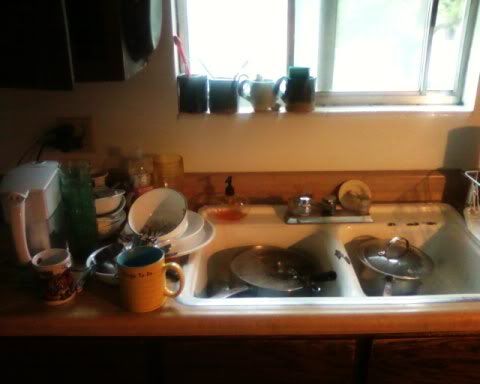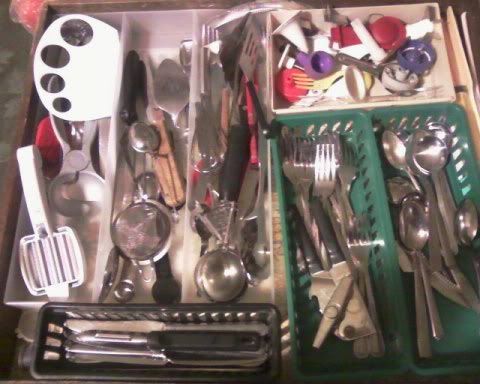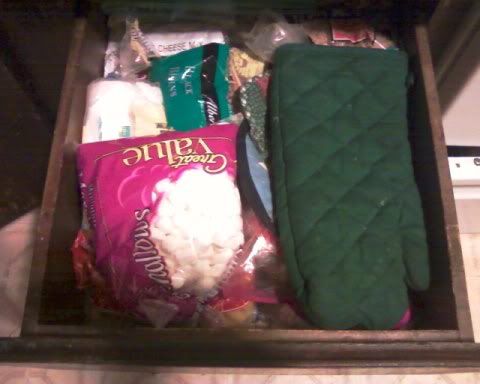
If you've answered yes, then clearly your cooking environment needs some work.
We like our work spaces to be clean don't we? Of course we do. Clutter can suck the lifeblood out of any initiative we may be feeling. This means we're more prone to sit in the mess we made and do nothing, which is clearly unacceptable. So, if you can't get work done while sitting at a messy desk, then odds are you won't be able to cook for yourself in a messy kitchen. Therefore, this is the first thing we must fix.
STEP ONE: INITIAL CLEANING
So, take an afternoon, order a pizza if you must, and clean the heck out of your kitchen. We're talking floors mopped, counter-tops wiped, and all dishes washed, dried, and neatly put away. I want the place sparkling and smelling of bleach. This will be the hardest, and most unpleasant part of the job, but trust me when I say it is crucial. By starting with a clean environment, we can make the next part of this process that much easier to plan.
STEP TWO: DISPOSAL
This, despite being a little dirty, can actually be fun. It gives us the chance to make a clean slate, and honestly, how can you hate doing that? The idea here is to remake our kitchen into a place we'd actually like to spend time in. Remember, cooking should never feel like a prison sentence.
I'm sure many of you have caught the wide variety of remodeling programs on Fine Living, and have probably flipped through more than a few magazines of that ilk at your local bookstore. And I'm sure all of us have gone "ooh" and "aah" at this photos, and strongly desired to make our kitchen look that sharp. Well, if you have the money and time on hand to do so, I say go for it. Hire Ty Pennington if it's in the budget, and make yourself that photo-worthy kitchen you've been lusting after. Personally, I can't afford it, and I'm guessing neither can you. So let's talk about the things we can do without spending a dime (a price I'm sure everyone can appreciate.)
Did you know that the most popular wedding and/or housewarming gift is kitchen gadgets? Friends and family alike are always happy to give you a new set of spatulas or whisks or something that they figure you'll surely need. And usually, this means that you the recipient, will end up with tons of kitchen stuff that gets stuffed away in drawers because you're too nice to throw it out. And then one day you reach into your drawer to get a spoon and see this:

Just looking at this picture I can see at least half a dozen things you won't need. A good kitchen should run lean, utilizing only the most needed tools that can multitask for a variety of uses, and can be stored without too much effort. We want simple utensils, basic equipment, and none of that fancy stuff that gets peddled on late night infomercials.
So, how do we know which stuff we can get rid of? It's easy, just follow this guide.
KEEP THE GADGET IF:
It's something you actually use.
GET RID OF THE GADGET IF:
It is too uncomfortable to use.
It feels like it's cheap enough to break if you did use it.
It's something you find in the back of a drawer with a thick coating of dust on it.
The last time you handled the tool was when you stuffed it in the back of the drawer.
You have more than one of the gadget in question.
Toss all this culinary detritus into a box. From there you can give it to goodwill, or take it around the neighborhood, letting people pick items they're missing from their kitchens. Either way, we don't want it in our homes any more. Clearing out any unused tools and gadgets makes space for the stuff we do use. And space, is a very valuable commodity in the kitchen.
Once we've gotten rid of the tools, let's poke around the drawers for edibles. Do you have a drawer in the house that looks like this?

If you've just nodded embarrassingly, then you know that this will not do. We typically keep any food we plan on eating in either the refrigerator or on dedicated shelves/counter-tops that are within our line of sight. Food items that end up in a drawer are most likely to be forgotten. We're quicker to go buy ourselves a new bag of beans than use the bag we bought a year ago. But, mom always taught us not to throw any food that's still good away, so there those beans sit, getting older and older.
Let me assure you, you will never eat those beans. And even if you did, they'll probably taste so bad, you'll wish you hadn't. You can attempt to donate them to a food bank if you like, but it's probably easier to just throw them away. Either way, get all of that old stuff out of there. If the item in question has been sitting unopened for more than a month, I say it becomes fair game for the trash can. Remember, the idea here is to start fresh, and to build up the most effective kitchen we can, not to hold onto unusable remnants.
STEP THREE: REDECORATION
Once all of that stuff is out of your kitchen, you can now look at how to use all that wonderful space you've made for yourself. Feel free to be as pretty as you want (this would look nice here, and this would be oh-so cute here,) but do remember that efficiency is very important in the kitchen. And you want the things you use the most close at hand. So factor that into your redesign. Place similar items in similar drawers, making it easier to grab more than one thing at the same time. Move cookware and appliances to a comfortably close distance to the stove. If you have toast at every meal, it probably wouldn't be a bad idea to have the toaster reasonably close to where you put food on a plate. There are safety factors to be considered in all this, obviously we don't want any injuries in our nice refurbished kitchen, but I think you're all smart enough not to put flammable items near the heat, or electrical items too close to the sink. If in doubt about your appliances, follow the recommendations on your user manuals (which hopefully you still have. If you feel there is even the slightest chance that something could catch on fire, or cause an electrical spark because of proximity to water, it's best to not take any chances.
Clearly, this is not a process that can happen easily. It may require an entire weekend to do it completely right, but the rewards are well worth it. By the end of it all, you'll be standing in a kitchen that is clean, comfortable, and enjoyable to be in. And when you're staring at this shiny room filled with your hard work and accomplishment, I guarantee there will be a voice in your mind that says, "I'd kind of like to cook something now."



No comments:
Post a Comment